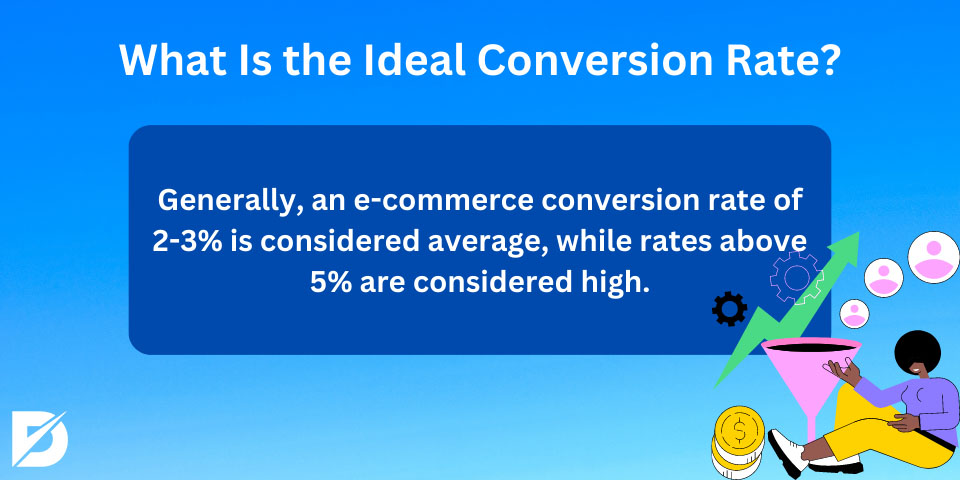There is no doubt that e-commerce has revolutionized the way we shop. With just a few clicks, we can now purchase almost anything we need from the comfort of our own homes. E-commerce has created unprecedented opportunities for businesses to reach new customers and grow their sales. But with so much competition out there, how can e-commerce businesses stand out and drive conversions? That’s where the e-commerce conversion rate comes in.
When it comes to e-commerce, the conversion rate is the percentage of website visitors who make a purchase. It’s a critical metric that can help businesses measure their success, identify areas for improvement, and optimize their marketing efforts. In this article, we’ll explore what e-commerce conversion rate is, why it matters, and ten strategies to improve it.
What Is the E-commerce Conversion Rate?
The E-commerce conversion rate is one of the most important metrics for any online business. It not only measures your website’s success but also reflects your digital marketing strategies effectiveness. However, the e-commerce conversion rate is not just a simple calculation of the percentage of visitors who make a purchase. There are many factors that can affect conversion rates, and understanding them can help businesses optimize their efforts to drive more sales and revenue.
Firstly, e-commerce conversion rates are not constant; they vary based on product, website design, and industry factors. Niche products at a higher price point may have lower conversion rates than popular products at a lower price point. Poor website design with unclear navigation, unintuitive functionality, and a complicated checkout process can leave potential customers confused and frustrated, resulting in lower conversion rates and lost revenue. Providing customers with a seamless and hassle-free shopping experience is vital for e-commerce businesses. It is important to invest in the functionality and design of the website to create a positive and memorable experience for customers, increasing conversion rates and driving long-term growth. Even with quality products and a booming industry, a poorly designed website can harm the reputation of the business and turn customers away.
What Is the Ideal Conversion Rate?
Generally, an e-commerce conversion rate of 2-3% is considered average, while rates above 5% are considered high. However, these benchmarks should be taken with a grain of salt, as conversion rates can vary widely depending on the factors mentioned above. In the world of e-commerce, the competition is fierce, and the stakes are high, which is why it’s crucial to focus on your own business and constantly strive to improve your conversion rates through effective marketing strategies and cutting-edge techniques.

While it’s tempting to get caught up in comparing yourself to other businesses and benchmarking your success against theirs, the truth is that every business is unique and faces its own set of challenges and opportunities. Therefore, by prioritizing your growth and optimizing your marketing efforts, you can unlock the full potential of your business and generate more sales, revenue, and customer loyalty than you ever thought possible. Remember, in the e-commerce game, the only competition that truly matters is the one you have with yourself – so go out there and conquer it with conversion rate optimization.
Why Does E-commerce Conversion Rate Matter?
E-commerce conversion rate matters because it directly impacts the success of an e-commerce business. A higher conversion rate means more sales and revenue, while a lower conversion rate means fewer sales and revenue. But conversion rate is more than just a measure of sales – it’s also an indicator of customer satisfaction and loyalty. A high conversion rate means that customers find what they need on the website, are satisfied with the products and services, and are more likely to return.
How to Improve Conversion Rates
So, what can e-commerce businesses do to improve their conversion rates? Here are some strategies that are really crucial to consider. Now that we’ve established the e-commerce conversion rate and why it matters. If you want to know what is conversion rate optimization, let’s dive into ten strategies to improve it.
Optimize the Website for Mobile
With more and more people using their smartphones to shop online, e-commerce businesses need a mobile-friendly website. This means designing a website that is easy to navigate, loads quickly, and optimized for smaller screens. Mobile optimization can include responsive design, which adjusts the website’s layout based on the screen’s size, and optimizing images and other content for faster loading times on mobile devices. Businesses can improve conversion rates and capture more sales by making it easy for customers to shop on their mobile devices.
Simplify the Checkout Process
The checkout process is a critical part of the e-commerce journey. To improve conversion rates, businesses should strive to make the checkout process as simple and straightforward as possible. This can include minimizing the number of steps required to complete the purchase, offering guest checkout, and displaying progress indicators. The goal is to make it easy for customers to complete their purchases and reduce the likelihood of cart abandonment.
Use High-Quality Product Images
High-quality product images can help showcase the product and give customers a better sense of what they’re buying. Images should be clear, well-lit, and show the product from multiple angles. In addition, businesses can use lifestyle images to show the product in use and help customers envision how it would fit into their lives. By providing high-quality, visually appealing, and detailed product images that showcase the unique features and benefits of the product, e-commerce businesses can improve the customer experience and instill confidence in their potential customers, ultimately leading to more conversions and increased sales revenue.

Offer Free Shipping
Shipping costs can be a major barrier to e-commerce conversions. Offering free shipping, even if it’s only for orders over a certain amount, can help incentivize customers to make a purchase. Free shipping can also help businesses stand out from competitors and improve customer satisfaction. By offering free shipping, businesses can remove a major obstacle to conversion and drive more sales.
Build Trust with Customers
Trust is essential for e-commerce conversions. Customers need to feel confident that they are making a safe and secure purchase and that the product will meet their expectations. Businesses can build trust by displaying customer reviews and ratings, prominently displaying return and refund policies, and using secure payment processing methods. In addition, businesses can showcase their expertise and authority in the industry by providing informative content, such as blog posts or product guides. Businesses can improve conversion rates and drive more sales by building customer trust.
Provide Excellent Customer Service
Excellent customer service is essential for e-commerce businesses. Providing responsive and helpful customer service can help build customer trust and loyalty, which can lead to repeat business and positive reviews. Businesses can provide excellent customer service by offering multiple channels for communication, such as email, phone, and live chat, and by responding promptly to customer inquiries and concerns. By providing excellent customer service, businesses can improve the customer experience and drive more conversions.
Offer Incentives
Offering incentives, such as discounts or free gifts, can help encourage consumers to make a purchase. For example, offering a discount code for first-time customers can be an effective way to incentivize conversions. In addition, businesses can offer incentives to customers who refer friends or who leave reviews on the website. By offering incentives, businesses can create a sense of urgency and excitement around purchasing, which can help drive conversions.
Optimize Product Descriptions
Product descriptions should be clear and detailed, highlighting the unique features and benefits of the product. Including keywords in product descriptions can also help improve search engine optimization (SEO) and attract more traffic to the site. In addition, businesses can use storytelling techniques to help customers connect with the product and understand how it fits into their lives. Businesses can improve the customer experience and drive more conversions by optimizing product descriptions.
Use Retargeting
Retargeting is a marketing technique that involves targeting customers who have already shown an interest in a product or service. Retargeting ads can be used to remind customers of the product and encourage them to return to the website and make a purchase. This can be especially effective for customers who have abandoned their cart or who have viewed a product multiple times but haven’t yet made a purchase. By using retargeting, businesses can stay top-of-mind with customers and drive more conversions.
Continuously Test and Optimize
Finally, e-commerce businesses should continuously test and optimize their website and marketing efforts to improve conversion rates. This can include A/B testing different website layouts, testing different marketing messages and offers, and analyzing website analytics data to identify areas for improvement. By continuously testing and optimizing, businesses can stay ahead of the competition and drive long-term growth.
To wrap up, if you are ready to take your e-commerce business to the next level, then listen up because here’s the secret to success: conversion rate optimization! This magical metric can help you measure how well your business is performing and boost your marketing efforts. Improving your e-commerce conversion rate can do wonders for your business- think more sales, happy customers, and explosive growth. But how can you make it happen? It’s all about the little things, like optimizing your website for mobile devices and providing top-notch customer service.
Last but not least, do not settle for mediocrity – continuously test and optimize your strategies to stay ahead of the competition. Your customers deserve the best, and you deserve to see your business thrive. So let’s get started and turn those clicks into cash!
Conclusion
In this article, we explained how e-commerce has revolutionized how we shop and how businesses can benefit from it by focusing on their e-commerce conversion rate. We explored the e-commerce conversion rate and why it matters and provided ten strategies to help businesses improve their conversion rates and ultimately grow their sales.
Frequently Asked Questions About
The E-commerce conversion rate is a metric that measures the percentage of website visitors who complete a desired action, such as making a purchase, signing up for a newsletter, or filling out a contact form.
The E-commerce conversion rate is important because it helps businesses understand how well their website and marketing efforts perform. By monitoring and improving their conversion rates, businesses can increase their sales revenue, build customer loyalty, and grow their business.
The formula for calculating the e-commerce conversion rate is as follows: Conversion Rate = (Number of Purchases / Number of Website Visitors) x 100% For example, if an e-commerce website had 10,000 website visitors in a month and 500 of them made a purchase, the conversion rate would be: Conversion Rate = (500 / 10,000) x 100% = 5% This means that for every 100 visitors to the website, 5 of them make a purchase.
There are many factors that can affect eCommerce conversion rate, including website design, user experience, product pricing, shipping costs, customer reviews, and overall trust in the business.
Businesses can improve their eCommerce conversion rate by optimizing their website design and user experience, offering competitive pricing and promotions, providing high-quality product images and descriptions, offering free shipping and returns, providing excellent customer service, and continuously testing and optimizing their marketing efforts.





No comments to show.